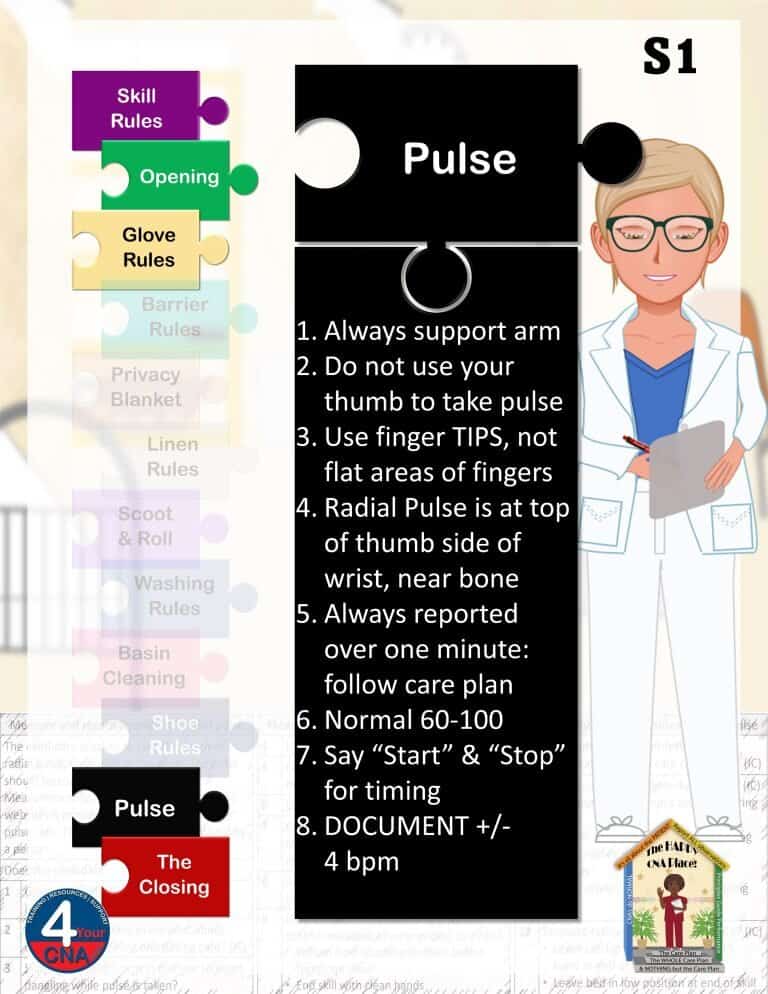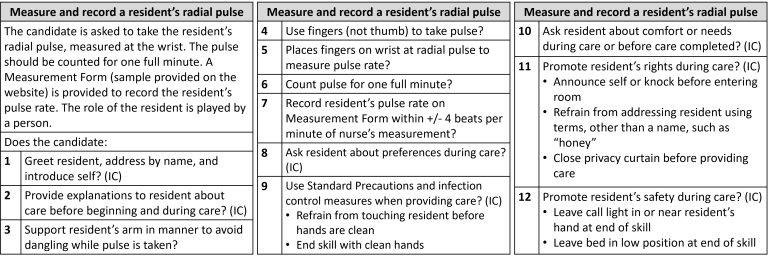Measure and Record Pulse
Introduction
Supplies
Steps
Common Testing Mistakes
Introduction
This video guides CNAs through the correct procedure to measure a resident’s radial pulse and accurately record the result — a key skill for caregivers and clinical staff.
Remember: Normal Pulse Rate is between 60-100 BPM. Always report abnormal values to the Nurse.
Supplies
You will need the following when Measuring and Recording Pulse:
- Documentation Sheet
- Pen
- Watch or Clock
Steps
1. Preparation & Hand Hygiene
- Read and follow the Care Plan, the whole Care Plan, and nothing but the Care Plan.
- Knock and announce yourself before entering.
- Greet the Resident by name and introduce yourself.
- Explain the task to the Resident and ensure their comfort and consent.
- Close the Privacy Curtain
- Wash your hands thoroughly before beginning.
- Assess Glove Rules (Are Gloves required for this Resident?)
2. Positioning the Resident
- Ask the Resident to extend one arm comfortably, palm up.
- Support the arm at the elbow and ensure the Resident is relaxed and sitting or lying calmly.
3. Locating the Radial Pulse
- Place the pads of your second and third fingers lightly on the thumb side of the Resident’s wrist, just below the base of the thumb.
- Don’t use your thumb, as it has its own pulse.
4. Counting the Pulse
- Once you feel the pulse, count the beats for a full 60 seconds to ensure accuracy.
- Remember to vocalize “Start” when you begin counting, and “Stop” when you finish counting. This ensures accuracy with the Evaluator.
- If counting for 60 seconds isn’t required (e.g., facility protocol), count for 30 seconds and multiply by two—verify with your site’s guidelines first.
- Remove fingers from the Resident’s wrist.
5. Address Resident Comfort
- Ensure Resident is comfortable.
- Ask about Resident needs and preferences.
- Provide Resident with Call light.
- Open the Privacy curtain and ensure bed is in lowest position.
6. Recording the Measurement
- Thoroughly wash your hands.
- Record the pulse rate (beats per minute).
- Record additional relevant observations: rhythm (regular vs irregular), strength (strong vs weak), and any other pertinent info on the appropriate form or electronic record.
- Thoroughly wash your hands.
- Think about the Steps of your Skill. Make any corrections. Tell the evaluator your Skills is complete.
Common Testing Mistakes
Avoid these common testing errors when taking a pulse:
- Not reading and following the Care Plan, the whole Care Plan, and nothing but the Care Plan.
- Not counting for the time indicated on the care plan
- Using a different pulse point other than radial
- Using your thumb to take the pulse
- Not documenting your reading
Remember: Normal Pulse Rate is between 60-100 BPM. Always report abnormal values to the Nurse.


Join our FREE Classroom Livestream on Mondays & Wednesdays from 9am – 1pm (ET) on FLCNATraining.com!
This course helped me pass the state test in Florida. Thank you 4YourCNA!
Ashley B.
Florida
Thank God I found this course before I tested! There was so much I didn't know about that I probably would have failed if it weren't for this course. If you want to pass your CNA exam, take this course!
Jaxmin L.
Louisianna
This course is AWESOME! I can't believe it was so fun! It taught me way more than the class I took, and this teacher actually answered my questions!
Megan P.
New York

